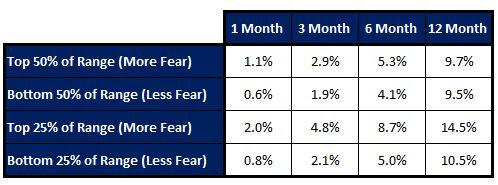
By Noah Solomon
Special to Financial Independence Hub
As I have written in the past, valuations are of no use for determining broad market returns over the short term.
To be clear, I am NOT implying that valuation doesn’t matter. Historical experience demonstrates that it has been an extremely powerful predictor of average returns over the long term. Without fail, whenever valuations have stood well below average levels, strong returns ensued over the next 7-10 years. Conversely, highly elevated valuations have preceded anemic or negative returns.
For investors interested in shorter-term market movements, sentiment indicators may harbor greater potential than their macroeconomic or valuation-based counterparts. In this month’s missive, I explore some of the more commonly cited indicators that purportedly possess short-term predictive capabilities to ascertain:
(1) Whether the historical record confirms the presence of any predictive power, and
(2) What these variables are signaling for markets in the near term.
The VIX Index: Embrace the Fear
The VIX Index represents the market’s expectations of the S&P 500 Index’s volatility over the next 30 days. Its level is derived from the prices of S&P 500 options with near-term expiration dates. Dubbed the “fear index,” the VIX is often used to gauge market sentiment, and in particular the degree of fear among market participants.
Historically, the VIX has served as a good, if imperfect indicator of market turning points:
- Although it failed to provide a clear “get out of dodge” signal before the peak of the tech bubble in early 2000, the VIX’s historically stratospheric level in late 2002 indicated a level of extreme fear that signaled that better times were at hand.
- In early 2007, the VIX stood at very depressed levels, indicating the high degree of complacency that contributed to the global financial crisis of 2008. Unfortunately, it was far too early in signaling the recovery. In October 2008, extremely elevated VIX levels were signaling the type of abundance of fear that often precedes rebounds, yet stocks still had plenty of downside before ultimately bottoming in March of 2009.
- More recently, the VIX failed to provide a warning signal of the market turmoil of 2022. However, its extremely elevated stance in late October of 2022 signaled that a rebound was imminent.
VIX Index Levels and S&P 500 Index Returns: 1997 – Present

Putting specific bear markets and recoveries aside, the above table demonstrates that elevated VIX/fear levels have on average preceded higher returns, and depressed VIX/lower fear levels have foreshadowed lower returns. The historical record lends credence to Buffett’s sage advice that it is wise for investors to be “fearful when others are greedy, and greedy when others are fearful.”
Put Call Ratio: Beware Cheap Insurance
Like the VIX Index, the put-call ratio (PCR) is widely used to gauge the overall mood of the market. Put options provide the right to sell stocks at a predetermined price and are often purchased as insurance to protect portfolios from market declines. Call options offer the right to buy stocks at a predetermined price and are frequently bought to capture upside participation when stock prices rise.
The PCR increases when the market participants’ desire for downside protection rises relative to their desire for upside participation. Alternately stated, a rise in the PCR is indicative of a rise in bearish sentiment. Conversely, the PCR falls when people become more focused on reaping gains than on avoiding losses, which is indicative of a rise in bullish sentiment.
Since 1997, the PCR has been a contrarian indicator, whereby elevated levels (high fear/low greed) have on average signaled higher returns and lower PCRs (low fear/high greed) have heralded subdued or negative results.
- In late 1999 – early 2000, the PCR stood in the bottom 5% of its historical range, which indicated that investors could not have been giddier and provided a clear warning signal that storm clouds were appearing on the horizon. By late February 2003, the PCR rose to levels which put it in the top 5% of its range, thereby registering a level of despondency that served as a prescient buy signal.
- Preceding the global financial crisis, the PCR failed to provide any definitive signal that a bear market was at hand. Although the ratio was registering the type of extreme fear that has at times preceded recoveries as early as March of 2008, the market still had plenty of downside left before bottoming in March of 2009.
- The PCR proved to be a superb “round trip” guidepost over the past couple of years. Having declined to historically depressed levels at the end of 2021, the ratio was illustrating a level of comfort among investors that left the door open to losses. By the end of 2022, the PCR stood at one of its highest levels in over 20 years, providing investors with a strong hint that better things might be in store for 2023.
Put-Call Ratio and S&P 500 Returns: 1997 – Present

As demonstrated above, the S&P 500 Index has generally performed better following elevated PCR levels than after the PCR has stood below its historical average.
When People Tell you how they’re Feeling, Believe them (Just don’t Follow them)
The American Association of Individual Investors (AAII) Sentiment Survey regularly asks investors where they think the market is heading in the next six months. When the percentage of bullish respondents far exceeds that of bearish ones, sentiment is deemed to be overwhelmingly positive, and vice versa.
The results of the survey have historically served as a contrarian indicator. High levels of pessimism have tended to precede strong returns, while high levels of optimism have tended to foreshadow challenging market environments.
- In late 1999 – early 2000, the number of bullish respondents exceeded that of bearish ones by one of the widest margins in history. Just as investors were convinced that stocks could only go up, a nasty prolonged bear market got underway. Fast forward to late February 2003, market participants were nothing short of apoplectic, with the AAII survey showing bears outnumbering bulls by a historically large amount. Lo and behold! It wasn’t long before markets began recovering with a vengeance.
- Although doom was not imminent when the AAII began registering abnormally strong bullish sentiment in October 2007, neither was there much upside left before markets began to crater. Even though sentiment reached one of its lowest levels on record by March 2008, markets still had plenty of downside before beginning to recover in March 2009.
- The AAII survey failed to provide a clear warning signal in late 2021 before the onslaught of 2022’s market swoon. However, its indication of extreme despondency in late 2022 did a far better job than most professional strategists in calling this year’s rebound.
As illustrated below, stocks have fared better following periods of increased bearishness than times when investors have been more optimistic.
AAII Sentiment Survey and S&P 500 Returns: 1994 – Present

Not Perfect, but Better than the Pros
The following table summarizes the efficacy of the three sentiment indicators in predicting past bear markets as well as subsequent rebounds (I have excluded the Covid crash and the subsequent rebound for obvious reasons). I define success as foreshadowing events within a sufficiently short timeframe such that investors could have added value by following the indicators’ signals.
Sentiment Indicators: Historical Success in Predicting Bear Markets & Subsequent Recoveries

- Overall, the VIX Index successfully signaled only one of the past three bear markets but has provided a valuable signal for two-thirds of subsequent recoveries.
- The PCR has fared somewhat better at identifying tops or near-tops in the market, flagging two of three bear markets. With respect to recoveries, the PCR’s track record mirrors that of the VIX, having identified the same two out of three recoveries.
- The AAII Survey has matched the PCR as a harbinger of market declines, flagging two out of three bear markets (albeit not the same two that the PCR flagged). It also presaged the same two recoveries as the PCR.
It goes without saying that there is no perfect market predictor, and the indicators which I have explored are no exception. Accordingly, they should be used with discretion and alongside other factors when evaluating what the future may have in store for markets. This having been said, all three sentiment indicators have done a better job than major Wall St. strategists, none of whom predicted any of the three bear markets, and who were by and large far too early or late with respect to their calls for subsequent recoveries.
Where we currently Stand
As of the end of July, all three indicators were signaling significant but not extreme levels of investor bullishness and complacency. Both the VIX Index and the PCR stood within the bottom quartiles of their historical range, while the number of bulls relative to bears was higher than 75% of historical observations.
By no means does this imply that investors should run for the hills. Even in instances where the VIX Index and the PCR stood in the lower portion of their historical ranges and the AAII survey was indicating greater than normal levels of bullishness, markets on average rose over the next 1-12 months, albeit less so than when these indicators were signaling broad-based pessimism.
Nonetheless, the fact is that returns have historically been less robust when sentiment gauges have been at current levels. From a portfolio positioning standpoint, this implies that investors should at the margin lean more defensively. In addition, at times when stock prices are rising at a slower pace or declining, dividends comprise a far larger slice of the total return pie. Lastly, many blue-chip Canadian companies currently offer dividend yields that are not only higher than yields on high-quality bonds, but are also taxed at a significantly lower rate.
Since its inception in October 2018, the Outcome Canadian Equity Income Fund has returned 57.0%, as compared to a gain of 49.0% for the TSX Composite Index and a gain of 44.1% for the TSX Dividend Aristocrats Index. Importantly, the fund has achieved this outperformance with lower volatility and shallower losses in declining markets.
Our Global Tactical Asset Allocation (GTAA) mandate has also exhibited strong defensive qualities, successfully protecting our clients from large losses during challenging markets, including late 2018, the Covid crash of early 2020, and more recently during last year’s bear market.
 Noah Solomon is Chief Investment Officer of Outcome Metric Asset Management. As CIO of Outcome, Noah has 20 years of experience in institutional investing. From 2008 to 2016, Noah was CEO and CIO of GenFund Management Inc. (formerly Genuity Fund Management), where he designed and managed data-driven, statistically-based equity funds. Between 2002 and 2008, Noah was a proprietary trader in the equities division of Goldman Sachs, where he deployed the firm’s capital in several quantitatively-driven investment strategies. Prior to joining Goldman, Noah worked at Citibank and Lehman Brothers.
Noah Solomon is Chief Investment Officer of Outcome Metric Asset Management. As CIO of Outcome, Noah has 20 years of experience in institutional investing. From 2008 to 2016, Noah was CEO and CIO of GenFund Management Inc. (formerly Genuity Fund Management), where he designed and managed data-driven, statistically-based equity funds. Between 2002 and 2008, Noah was a proprietary trader in the equities division of Goldman Sachs, where he deployed the firm’s capital in several quantitatively-driven investment strategies. Prior to joining Goldman, Noah worked at Citibank and Lehman Brothers.
Noah holds an MBA from the Wharton School of Business at the University of Pennsylvania, where he graduated as a Palmer Scholar (top 5% of graduating class). He also holds a BA from McGill University (magna cum laude). Noah is frequently featured in the media including his regular column in the Financial Post.
This article originally appeared in the July 2023 issue of the Outcome newsletter and is republished here with permission.

